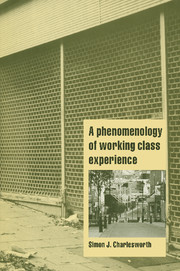Book contents
- Frontmatter
- Contents
- Acknowledgements
- 1 Introduction: Dead Man's Town
- 2 Rotherham: history, demography and place
- 3 Class and the objectifying subject: a reflexive sociology of class experience
- 4 A landscape with figures?
- 5 Understanding the barriers to articulation
- 6 Necessity and being working class
- 7 The culture of necessity and working class speech
- 8 Conclusion
- Notes
- References
- Index
4 - A landscape with figures?
Published online by Cambridge University Press: 22 September 2009
- Frontmatter
- Contents
- Acknowledgements
- 1 Introduction: Dead Man's Town
- 2 Rotherham: history, demography and place
- 3 Class and the objectifying subject: a reflexive sociology of class experience
- 4 A landscape with figures?
- 5 Understanding the barriers to articulation
- 6 Necessity and being working class
- 7 The culture of necessity and working class speech
- 8 Conclusion
- Notes
- References
- Index
Summary
Tevershall village – a village which began almost at the park gates, and trailed in utter hopeless ugliness for a long and gruesome mile: houses, rows of wretched, small begrimed brick houses with black slate roofs for lids, sharp angles and wilful blank dreariness.
Connie was accustomed to Kensington or the Scotch hills or the Sussex downs: that was her England. With the stoicism of the young she took in the utter soulless ugliness of the coal-and-iron Midlands at a glance, and left it at what it was: unbelievable, and not to be thought about.
(Lawrence 1994a: 13)Space, of course, is alive
that's why it moves about;
and that's what makes it eternally spacious and unstuffy.
And somewhere it has a wild heart
that sends pulses even through me …
(Lawrence 1992: 192)There is an internal landscape, a geography of the soul; we search for its outlines all our lives.
(Hart 1991: 1)Lady Chatterley's Lover by D. H. Lawrence provides an insight into the ways in which comportment discloses perception, sense and experience. It illuminates the ways in which human beings' relation to the world is mediated by the way of life of their immediate class group. That is how the form of their relation to the world is inscribed in the immediate dispositions through which individuals come to be in the world as a place of the determinate sense inscribed in an individual's and group's position and location.
- Type
- Chapter
- Information
- A Phenomenology of Working-Class Experience , pp. 86 - 130Publisher: Cambridge University PressPrint publication year: 1999

